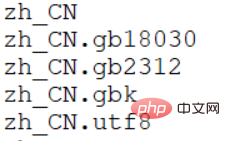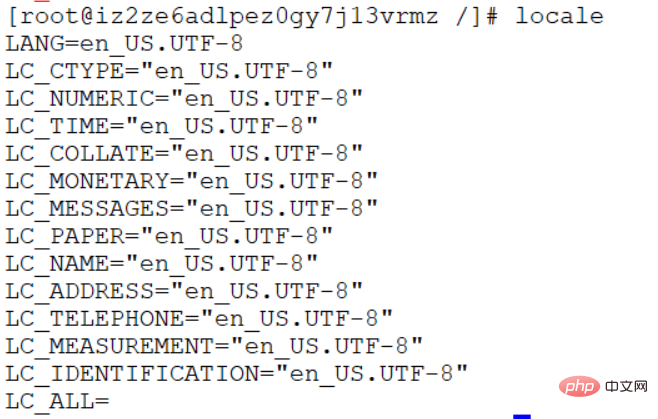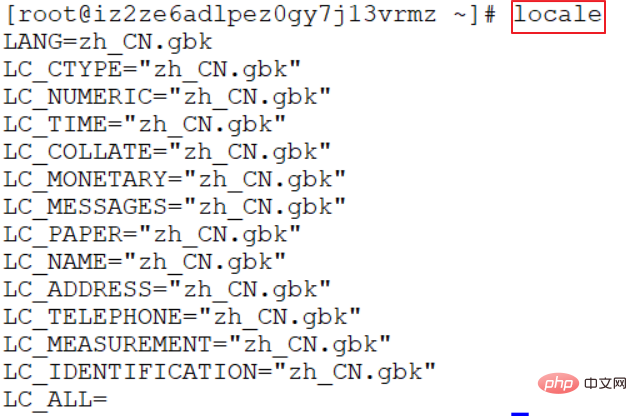
 Check whether the Chinese package is installed
Check whether the Chinese package is installed
You can use the following naming to check whether the Chinese installation package is installed on the system.
locale -a |grep "zh_CN"

There is no output, indicating that it is not installed. Enter the following command to install:
yum groupinstall "fonts" -y
The installation is complete, check which Chinese language packs are installed
[root@iz2ze6adlpez0gy7j13vrmz /]# locale -a | grep "zh_CN" zh_CN zh_CN.gb18030 zh_CN.gb2312 zh_CN.gbk zh_CN.utf8
Indicates that the Chinese language pack has been installed on the system and there is no need to install it again. Important note, if your system still cannot use Chinese after following the steps below, please try the above encoding methods one by one. For example, change LANG="zh_CN" to LANG="zh_CN.gb18030".
Before modifying the configuration file, let’s take a look at the current system language environment:
# echo $LANG en_US.UTF-8 # locale LANG=en_US.UTF-8 LC_CTYPE="en_US.UTF-8" LC_NUMERIC="en_US.UTF-8" LC_TIME="en_US.UTF-8" LC_COLLATE="en_US.UTF-8" LC_MONETARY="en_US.UTF-8" LC_MESSAGES="en_US.UTF-8" LC_PAPER="en_US.UTF-8" LC_NAME="en_US.UTF-8" LC_ADDRESS="en_US.UTF-8" LC_TELEPHONE="en_US.UTF-8" LC_MEASUREMENT="en_US.UTF-8" LC_IDENTIFICATION="en_US.UTF-8" LC_ALL=
Although the Chinese language pack is installed However, the language environment of this machine is not Chinese. You need to modify the locale.conf configuration file
# vim /etc/locale.conf LANG="zh_CN" # source /etc/locale.conf
vim /etc/locale.conf 进入编辑页面,输入i开始编辑,编辑完成输入esc到底行模式,然后输入:wq,保存并退出

You can also use the command to modify the locale.conf configuration file:
# localectl set-locale LANG=zh_CN
Check the current locale afterwards:
# echo $LANG zh_CN # locale LANG=zh_CN LC_CTYPE="zh_CN" LC_NUMERIC="zh_CN" LC_TIME="zh_CN" LC_COLLATE="zh_CN" LC_MONETARY="zh_CN" LC_MESSAGES="zh_CN" LC_PAPER="zh_CN" LC_NAME="zh_CN" LC_ADDRESS="zh_CN" LC_TELEPHONE="zh_CN" LC_MEASUREMENT="zh_CN" LC_IDENTIFICATION="zh_CN" LC_ALL=
[root@node2 ~]# date 2017年 10月 16日 星期一 16:30:24 CST
locale -a |grep "zh_CN": List the names of all available public locales, and then filter Chinese
locale -a: List the names of all available public language environments.
If you can see the following items, it also means that the system has installed the Chinese language pack. No need to install anymore, so what do these items mean?

##{Language code}_{Country code}.{Character set}
zh is Chinese The code name, CN is the code name of China, gb18030, gb2312, utf8 is the language character set
Then each item can be commonly understood as "You speak Chinese, you are in China, language The character set is gb18030/gb2312/utf8”
If the above items are not found, manually install the Chinese language pack
# yum install kde -l10n-Chinese (about 11M)
locale: View the current system language environment

LANG: The language of the current system
LC_CTYPE: Language symbols and their classification
LC_NUMERIC: Numbers
LC_COLLATE: Comparison and sorting habits
LC_TIME: Time display format
LC_MONETARY: Currency unit
LC_MESSAGES: Information mainly includes prompt information, error information, status information, titles, labels, buttons and menus, etc.
LC_NAME: Name writing method
LC_ADDRESS:Address writing method
LC_TELEPHONE:Phone number writing method
LC_MEASUREMENT:Weights and measures expression
LC_PAPER: Default paper size
LC_IDENTIFICATION: Overview of the information contained in the locale itself
LC_ALL: The variable with the highest priority. If this variable is set, all LC_* and LANG variables will be forced to follow its value
Restart the system
# reboot
Use remote tools When connecting, if Linux has Chinese files or directories, garbled characters will appear during display. The reason is that the Linux encoding is UTF-8, and the remote tool defaults to the current system local encoding, which is GBK. So the solution is to unify the encoding of both. However, the SSH Secure tool cannot set the encoding, so the encoding is unified by modifying the system encoding of Linux.
Step one: Check the locale of the current system.
Step 2: Modify the configuration file locale.conf
# vim /etc/locale.conf
执行下面的命令,让修改生效。
# source /etc/locale.conf
输入date验证。如果还有问题,也可以reboot重启一下。

推荐教程: 《CentOS教程》
The above is the detailed content of How to solve the Chinese garbled problem in centos7. For more information, please follow other related articles on the PHP Chinese website!




